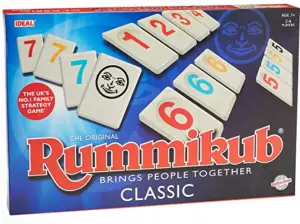 Do you enjoy playing games that are both fun and challenging? If so, then you will love Rummikub! This exciting and challenging tile game can be played by people of all ages, and it is a great way to spend time with friends and family. Let’s get started!
Do you enjoy playing games that are both fun and challenging? If so, then you will love Rummikub! This exciting and challenging tile game can be played by people of all ages, and it is a great way to spend time with friends and family. Let’s get started!
Rummikub is a tile-based game that can be played by two to four players. The objective of the game is to be the first player to get rid of all of your tiles. Each player begins the game with fourteen tiles, which are numbered from one to thirteen and come in four different colors: red, yellow, blue and black. The tiles are then shuffled and placed face down in front of the players or placed in a bag and shaken (this is how I play).
To begin the game a player can only start by playing at least three tiles with a total face value of 30 points or over. If they cannot do this, they draw a new tile to add to the fourteen already in their pile, and it is the next player’s turn. Play continues like this until someone can start with thirty points. The next player still cannot make their first move without first playing three or more tiles for a score of thirty. After their first go, a player can play any amount of tiles of any value to complete a turn. If at any time you cannot make a move, then you must pick up another tile. In some games players can end up with quite a few!!
When it’s a player’s turn, they either play down one of their tiles or, if they can’t go, they draw one tile from the stack (or bag) and add it to their hand. If the player can place a tile, they must put it down in such a way that it creates a row or column of at least three tiles with matching numbers or colors. For example, if there are three different coloured tiles numbered “12” on the board, you can then place a fourth different coloured tile with a 12 on it next to them. As another example, you could create a ‘run’ of numbers using any colour but they must all be the same colour. So, a player could place a black “11” next to a black “12” and then add a black “13”. As long as the numbers are in sequence, it doesn’t matter what order they are played in.
If at any point during the game a player is unable to make a move, they must draw a tile from the remaining stack each turn until they can play again. The game ends when one player has no more tiles remaining in their hand or when the final tile has been drawn from the stack and nobody can make a move. The player with the lowest score at the end of the game is declared the winner!
Part of the skill of Rummikub is by adding single tiles to ones that are already played. For example, if there is a run of black tiles “10-11-12” on the table, a player could place a black “9” next to the “10” or a black “13” next to the “12”. By doing this, players can extend runs and sets that are already on the table. A player could also take a number from a group of four or more on the table to add to two of their own currently unplayable tiles. For example, if there is a run of red tiles “10-11-12-13” on the table, a player could move the “10” tile to connect with other “10” tiles of other colours, thus allowing you to make a move.
The game of Rummikub is won by being the first player to play all of the tiles from their rack. When a player has no more moves that they can make, they must draw a tile from the bag and continue playing. The game ends when one player has no more tiles left on their rack. The other players then add up the values of the tiles remaining on their racks. The player with the lowest score is the winner!
When you become skilled at playing Rummikub it’s possible to make very complicated moves involving many tiles. Sometimes these moves don’t quite work out and it may be difficult to remember where you started moving the tiles. I now take a photo of the board before I start my move – just in case!
So there you have it! That’s how you play Rummikub

